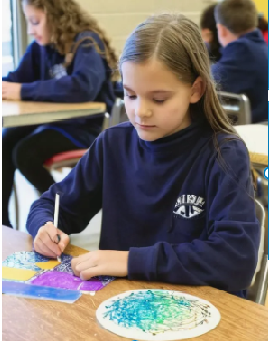Bullying Roleplay Script: The Unkind Comment Incident #1

|
Getting your Trinity Audio player ready...
|
Bullying Roleplay Characters & Setting
Characters:
- Emma (Target): A student who loves drawing and spends her free time creating art.
- Jake (Bully): Another student who has been teasing Emma by making unkind comments, calling her weird, a loser, saying she has no friends, and making fun of her clothes.
Setting: The school cafeteria during lunchtime.

Bullying Roleplay Instructions
- Group Formation: Divide the students into pairs, assigning one student as the bully and the other as the target. Names and genders can be adjusted as needed.
- Familiarization: Instruct students to familiarize themselves with their designated roles and the provided script.
- Express Authentically: Emphasize the importance of authentic expression of emotions and responses. Ensure each child feels comfortable in their role.
- Time to Perform: Prompt students to act out both the resilient and non-resilient responses based on the script.
- Discussion: After the role-play, lead a discussion to encourage reflection on their experiences. Explore the impact of different responses and provide a platform for students to share their thoughts and feelings about the exercise.
Bullying Roleplay Script
Opening Scene:
Emma is sitting alone at a table, engrossed in her art project.
Jake approaches, accompanied by a small group of friends.
Jake (Bully):
(mockingly) “Hey, it’s Emma, the ‘Weirdo with no friends’! Just stop drawing, Loser? No one cares about your weird art. And by the way, you should go home and change because those clothes look horrible on you.”
Resilient Response:
Emma maintains her composure, continues working on her art, and responds with confidence.
Emma (Confidently):
“Hey Jake, your opinion is noted, but I’m going to keep doing what I love. Have a great day!”
Emma continues working on her art, seemingly unbothered and maintains her focus.
Jake (Bully):
(mockingly) “Hey, it’s Emma, the ‘Weirdo with no friends’! Just stop drawing, Loser? No one cares about your weird art. And by the way, you should go home and change because those clothes look horrible on you.”
Non-Resilient Response:
Emma looks down, visibly upset, and stops working on her art, avoiding eye contact.
Emma (Expressively):
“Why do you always have to be so mean, Jake? It hurts. I’m just trying to express myself through my art. It may seem weird to you, but it’s a part of who I am. I wish you could understand that.”
End Scene
Resilient Response Analysis: Empowering Strategies for Facing Bullying
Resilient Response:
- Effect on Emma: Emma maintains her composure, confidently asserting her right to enjoy her interests. She remains focused on her art, signaling that Jake’s comments do not have power over her.
- Impact on Jake: Jake’s attempts to belittle Emma are met with confidence, potentially diminishing his satisfaction in trying to bring her down.
- Possible Outcome: Emma’s resilience might discourage further bullying as Jake sees that his words are not causing the desired effect. Additionally, others witnessing the exchange may be inspired by Emma’s strength.
Non-Resilient Response:
- Effect on Emma: Emma feels upset, overwhelmed by Jake’s comments. She withdraws from her art, internalizing the negativity and expressing a sense of isolation.
- Impact on Jake: Jake’s bullying may be reinforced as Emma’s reaction aligns with his desire to demean and hurt her emotionally.
- Possible Outcome: Emma’s non-resilient response may perpetuate the cycle of bullying, potentially leading to more frequent and intense incidents. It could also impact Emma’s mental well-being, contributing to a negative self-image.
Discussion Points:
- Empowerment Through Resilience: The resilient response empowers Emma, demonstrating that she controls her emotions and reactions. This can deter further bullying attempts and promote self-confidence.
- Breaking the Cycle: Non-resilient responses may inadvertently encourage bullies by providing them with the reaction they seek. Discussing the cycle of bullying and how resilience can break that cycle is crucial.
- Positive Peer Influence: Highlight the role of peers in shaping the social environment. A resilient response can inspire others to support Emma, fostering a culture of empathy and solidarity.
Encouraging students to reflect on these differences can deepen their understanding of the impact of their responses to adversity and contribute to the development of a more compassionate and supportive school community.
What Does Research Say About the Effectiveness of Using Roleplays to Decrease Bullying?
Research from various studies highlights the effectiveness of role-playing in reducing bullying and fostering resilience among students.
In a study exploring the role-exchange playing paradigm (Gu et al.), students engaging in successive roles within simulated events experienced increased moral correctness, empathy, and a stronger commitment to prevent bullying.
Another study conducted in an Irish school (Donohoe) emphasized a significant decrease in bullying incidents after implementing role-playing techniques.
A third study (Holmgren et al.) conducted in a middle school used role-playing, among other strategies, to decrease bullying behaviors.
References:
- Gu, X., Li, S., Yi, K., Yang, X., Liu, H., & Wang, G. (2023). Title of the Role-Exchange Playing Paradigm Study. Journal Name.
- Donohoe, P. (2019). Title of the Ireland Pilot Study. International Journal of Bullying Prevention, [Online First]. doi:10.1007/s42380-019-00036-4.
- Holmgren, J., Lamb, J., Miller, M., Werderitch, C. (2011). Title of the Student Surveys Study. Unpublished master’s thesis, Saint Xavier University, Chicago, Illinois.






